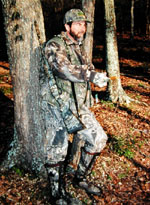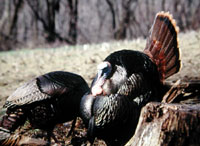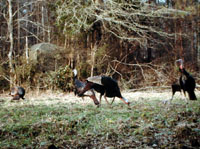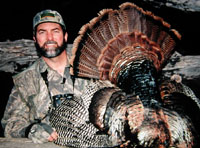
|
Features
|
|
|
|
Books
|
|
|
|
Fun & Games
|
|
|
|
Contact Us
|
|
|
John's Journal... Entry 141, Day 3
MASTERING TURKEY TALK WITH WILBUR PRIMOS
The Kee-Kee Run, The Gobble and Drumming
 EDITOR'S
NOTE: Turkey hunters understand the basic language of turkeys, but
perhaps not the subtleties of that language. Often the subtle variations
in the volume, rhythm and pitch of a turkey's call mean just as much as
the kind of call it is. Sometimes these variations may mean even more.
The most skillful turkey hunters -- the masters of the sport -- know how
to add these subtleties to their calling. This week, avid deer and turkey
hunter, Wilbur Primos of Jackson, Mississippi, the founder of Primos Game
Calls, will share some of his secrets to use turkey talk effectively to
attract even the most stubborn birds.
EDITOR'S
NOTE: Turkey hunters understand the basic language of turkeys, but
perhaps not the subtleties of that language. Often the subtle variations
in the volume, rhythm and pitch of a turkey's call mean just as much as
the kind of call it is. Sometimes these variations may mean even more.
The most skillful turkey hunters -- the masters of the sport -- know how
to add these subtleties to their calling. This week, avid deer and turkey
hunter, Wilbur Primos of Jackson, Mississippi, the founder of Primos Game
Calls, will share some of his secrets to use turkey talk effectively to
attract even the most stubborn birds.
The Kee-Kee Run:
A young turkey doesn't come equipped with adult turkey language and has
to use the calls he or she is able to make. The kee-kee run is like the
words of a child just learning to talk. It's the call that a young hen
or a gobbler makes when attempting to yelp, but the sound is more like
whistling than yelping. Young turkeys use the kee-kee to locate their
mamas or the rest of the flock. But it's not just a call they use when
they're lost. They also use it when they're milling around in a flock
together.
 Most
hunters will make the kee-kee run in the fall. They'll bust up a flock
of turkeys and then try to call them together and draw a gobbler into
gun range. However, I'll use the kee-kee in the spring as well. This call
is especially effective for old toms that are reluctant to gobble. A tom
usually will gobble in answer to a high-pitched call. When a crow flies
over and gives a high-pitched call, a tom generally will gobble at it.
Since the kee-kee has a high pitch, many times you can give it in the
spring and make an older gobbler croak out a mating call. Also, some young
gobblers will still kee-kee in the spring. So it's not out of character
for a young gobbler to kee-kee and for an older gobbler to answer.
Most
hunters will make the kee-kee run in the fall. They'll bust up a flock
of turkeys and then try to call them together and draw a gobbler into
gun range. However, I'll use the kee-kee in the spring as well. This call
is especially effective for old toms that are reluctant to gobble. A tom
usually will gobble in answer to a high-pitched call. When a crow flies
over and gives a high-pitched call, a tom generally will gobble at it.
Since the kee-kee has a high pitch, many times you can give it in the
spring and make an older gobbler croak out a mating call. Also, some young
gobblers will still kee-kee in the spring. So it's not out of character
for a young gobbler to kee-kee and for an older gobbler to answer.
 The
Gobble:
The
Gobble:
The gobble is the mating call of the male turkey, given in the spring
to attract hens. Many hunters overlook the gobble. But any hunter who
wants to become a master caller must learn how and when to use the gobble.
A realistic gobble is probably the most difficult call the hunter has
to make. Very few hunters can gobble well with their mouths, but many
can learn to gobble with a snuff-box call. By using your throat, your
lips and your finger to strum the inside rubber of the snuff-box, you
can make a very effective gobble. The gobble is potent on old turkeys
and young ones but is seldom effective on middle-aged turkeys. An old
gobbler will get jealous when he hears a gobble and will come in to fight.
A young bird, when he hears a gobble, will assume there's a flock of turkeys
in the neighborhood and will want to join them. A middle-aged gobbler,
however, is usually reluctant to challenge an older gobbler or to fool
with a younger one. Therefore, when you gobble, you separate turkeys into
age groups -- those that will come and those that won't.
 Drumming:
Drumming:
Drumming is a sound that gobblers make in the spring when they're strutting.
A drumming call can sometimes be heard 150 yards away in the woods. At
times, I've been in the woods with hens in front of me, and then behind
me I've heard a gobbler drumming. As I've watched, the hens will come
to attention and go running to him. For that reason, I know drumming is
one of the turkey's mating calls. The sound is made deep in the gobbler's
chest and is very resonant and hollow. The best way to describe drumming
is to say it sounds like an 18-wheeler shifting gears. Often, I've been
in the woods and heard an 18-wheeler several miles away slow down and
shift gears, and I haven't been sure whether I've heard the 18-wheeler
or a turkey drumming. The sound is "Vroomm!" Few hunters use the drumming
call, but drumming can be practiced, learned and used very effectively
to take gobblers. The best way to learn what drumming sounds like and
how to imitate it is to find a wild turkey in captivity and watch him
and listen to him in the spring. As you listen, practice the drumming
sound with your mouth. Oftentimes you can use a drumming call alone to
get a gobbler to come to you. Drumming is also productive when an older
gobbler hangs up 50 or 60 yards from you, and you can't decide whether
to gobble at him or not. If he's a sub-dominant turkey, a gobble may run
him off. I'll usually give the drumming call, and many times that will
break him out of his strut. Even if he hasn't been strutting, it will
bring him in to check out this other gobbler drumming near the hens he
thinks he's heard.
When the weather is inclement, or when dogs or hunters have harassed the turkeys, turkeys will drum rather than gobble. Most of the time, they'll be drumming on the limbs in the mornings before they fly down. If you listen for that drumming in the morning, many times you can find a turkey without having to hear him gobble.
TOMORROW: THE CACKLE
Check back each day this week for more about the Mastering Turkey Talk With Wilbur Primos...
Day 1 - The Tree Call, The
Hen-Turkey-Wing Call and The Lost Call
Day 2 - The Yelp, The Cluck and The Putt
Day 3 - The Kee-Kee Run, The Gobble and Drumming
Day 4 - The Cackle
Day 5 - Cutting, The Wavy Call and The Purr